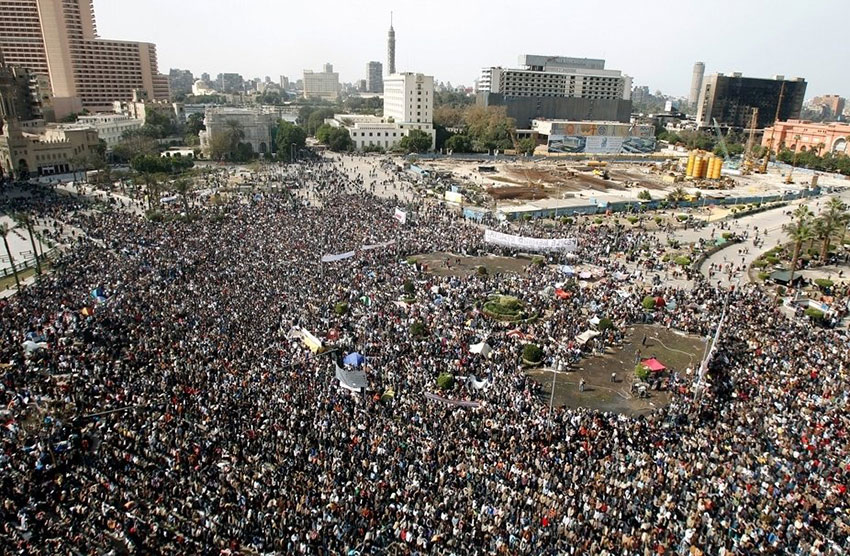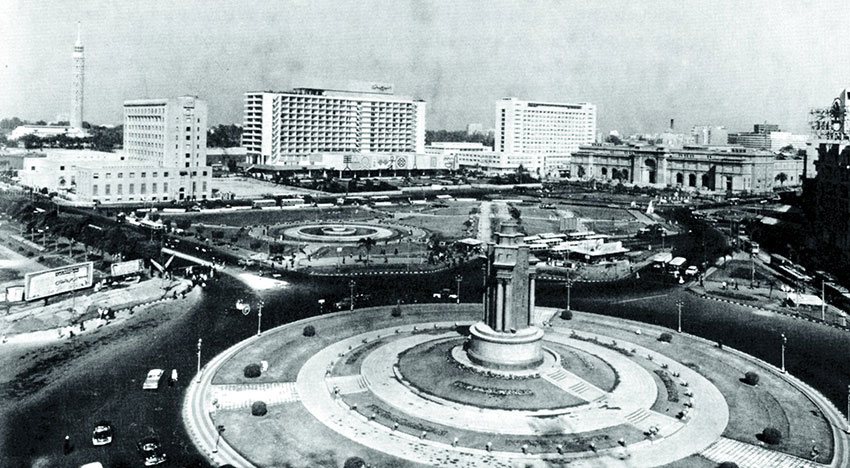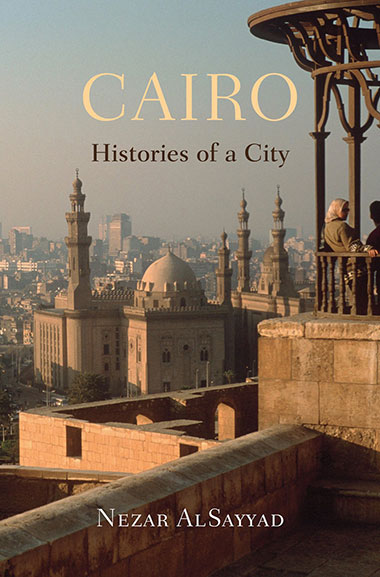

Nezar AlSayyad is Professor of Architecture and Urban History, and Chair of the Center for Middle Eastern Studies at the University of California, Berkeley, and the author of the recently released Cairo: Histories of a City. In February, he wrote here of the powerful financial interests involved in the reshaping of Egypt’s political system. Now, while international attention has shifted to the war in Libya, AlSayyad steps back to reflect on the history of Cairo’s Tahrir Square, a space that has finally earned its name.
The recent revolution in Cairo has made Tahrir Square a household name. No one, not even a historian who has written a book on the city, could have imagined that this aptly named public space would nurture a spark that would set the entire Middle East ablaze.

Tahrir, which means liberation in Arabic, is one of the oldest squares in modern Cairo. The images of the square recently aired during broadcast coverage of the uprising—images now engraved in the minds of people all over the globe—were taken from the rooftops of the few high-rise buildings situated south of the square. Just beyond this location, looking west and north, is a collection of overlooked buildings that capture the history of modern Egypt and render the revolutionary happenings in Tahrir Square all the more poignant.

A photograph of the square from the early 1960s helps tell the story. Appearing under the Cairo tower is the headquarters of the Arab League and next to it is the former Hilton Hotel, which is currently under renovation as a new Ritz-Carlton. North of the hotel is the salmon-colored Egyptian Museum and behind it is a building that would ultimately become the headquarters for President Hosni Mubarak’s National Democratic Party (NDP). In the foreground is a statue-less pedestal crowning a green roundabout. Each of these landmarks plays a role in the making of modern Cairo, a city that is nearly four thousand years old. Most scholars would agree that the city is only one thousand years old, but its metropolitan expansion in the twenty-first century engulfed all earlier settlements from Memphis to Giza, making Cairo many millennia older.
During the time of the Ancient Egyptians, the square was simply a patch of desert. By the time the Fatimids established Al-Qahira (which was later Anglicized into Cairo) in the tenth century, the Nile River had changed its course and swallowed much of this land. The area later became marshland covered by water during flood seasons. Toward the end of the eighteenth century, by the time Napoleon occupied Cairo, the land had dried up enough to allow the French forces to camp there. It was not until the time of Mohamed Ali, the founder of modern Egypt, that the network of barrages built to control the flow of the river, stabilized the banks of the Nile in Cairo.
The 500 acre open space housed cultivated fields, gardens and many royal family palaces during Khedive Ismail’s reign. Ismail, the grandson of Mohamed Ali, came to be known as the founder of modern Cairo. Having lived in Paris during the remake of the city by Baron Haussmann, Ismail embarked on the project of modernizing the city in many ways, one of which was to build a district later named after him. In the center of this district was a square that carried the same name, Ismailia square.
The square, however, had an undefined form until the Egyptian Museum was built in its northeastern corner. Ismail’s modernization projects plunged the country into great debt, and he was the first ruler of modern Egypt to be removed from power—in this case, foreign forces did the ousting. The British occupation of Egypt ensued into the waning years of the nineteenth century. The British stationed their troops west of the square in Ismailia, in what Egyptians often called the English Barracks.
During the early part of the twentieth century, the Ismailia district emerged as the downtown of modern Cairo and it expanded toward the square, which had to be replanned to facilitate the newly introduced vehicular traffic in Cairo. The roundabout in the southern part of the square was consequently built. A few decades later, during the reign of King Farouk, the space acquired the statue-less pedestal. Farouk had commissioned a statue of his grandfather, Khedive Ismail, to be built for the pedestal. The Arab League headquarters were also built during this time, thus defining the eastern side of the square.
The square witnessed its first serious demonstrations during the same era. Opposition to British presence in Egypt sparked protests and skirmishes, with police killing two dozen Egyptians by Feb. 11, 1946. (On the same day, 64 years later, President Mubarak was forced to step down. An accident of history?)
Dissatisfaction with King Farouk’s government brought about another set of protests that resulted in the Great Fire of Cairo on Jan. 25, 1952. A few buildings in the square were casualties of the blaze. (On the same day, 59 years later, the Egyptian people descended upon Tahrir Square in unprecedented numbers to protest their government. Another accident of history, perhaps!)
The 1952 fire was a precursor to an Army coup, led by Gamal Abdul Nasser on July 23, that transformed Egypt from a sleepy kingdom into a revolutionary republic. In the following decade, President Nasser issued a government decree changing the name of the square from Ismailia to Tahrir to commemorate the departure of the British from Egypt.
 In the early 1960s, the Hilton Hotel was built on the site of the former English Barracks. Next to it was a building intended to house the Cairo Municipality but that actually became the headquarters of Nasser’s Arab Socialist Union, the single party that governed Egypt for much of his rule. This was the building that Mubarak’s NDP later inherited—a building set ablaze by protestors during the recent 2011 demonstrations.
In the early 1960s, the Hilton Hotel was built on the site of the former English Barracks. Next to it was a building intended to house the Cairo Municipality but that actually became the headquarters of Nasser’s Arab Socialist Union, the single party that governed Egypt for much of his rule. This was the building that Mubarak’s NDP later inherited—a building set ablaze by protestors during the recent 2011 demonstrations.
In a twist of irony, the statue of Khedive Ismail, King Farouk’s grandfather, did arrive in Egypt a few weeks following the 1952 revolt. It was never placed on its pedestal, of course. The symbolism of the empty pedestal, a remnant of Egypt’s failed monarchy, was a landmark Nasser left untouched. The pedestal remained in place until the 1970s when construction of a metro system necessitated its removal. During Anwar Sadat’s time as president, Tahrir Square acquired Cairo’s first metro station, which was named after Sadat during Mubarak’s rule. The southern part of the square was also renamed Sadat Square, although Cairenes never referred to it as such. They limited their use of the name to the metro station.
The Egyptian people have long accepted July 23,1952, as their day of revolution but they never recognized Tahrir Square as the symbol of their liberation. That all changed on Jan. 25, 2011. It is too soon to comprehend the full impact of what happened in Tahrir Square during the 18 days that followed. But whatever it is, Egypt and the Arab world will never be the same again. Social media has given a new life to the city and has reminded us that public space will always remain a vibrant arena for public discourse and revolutionary change.
(Photographs provided courtesy of the Egyptian Magazine Weghat Nazar.)